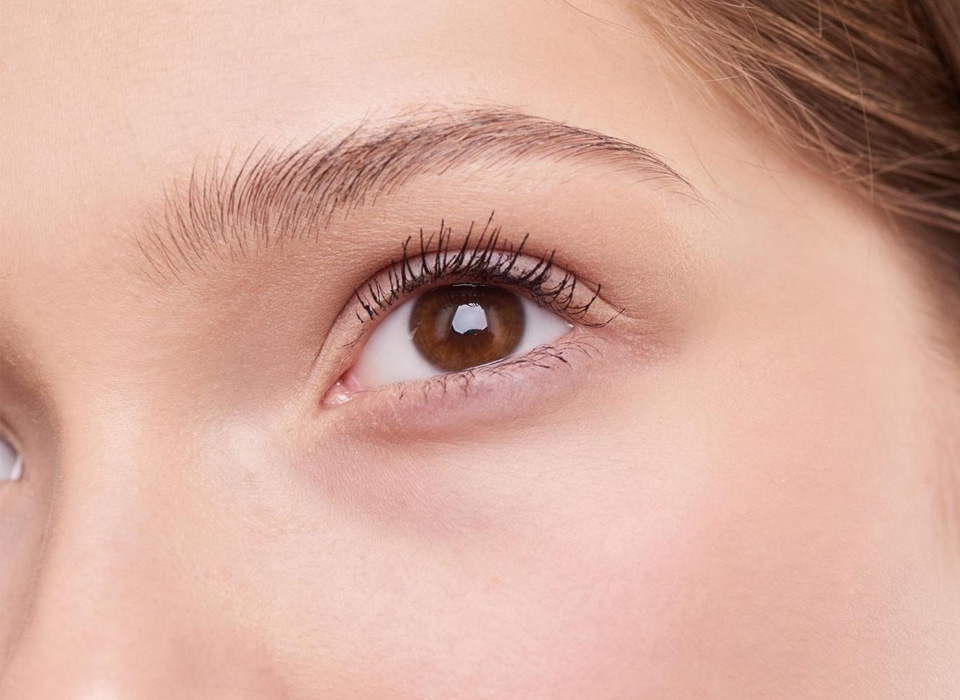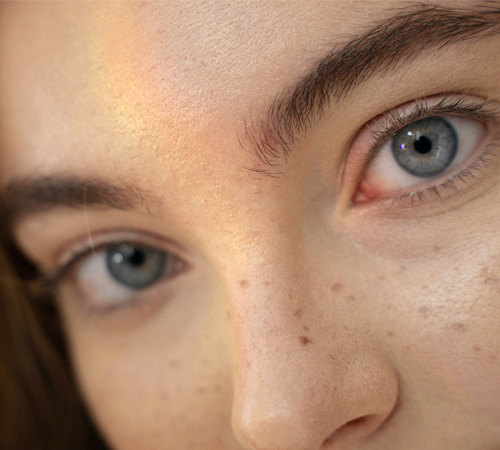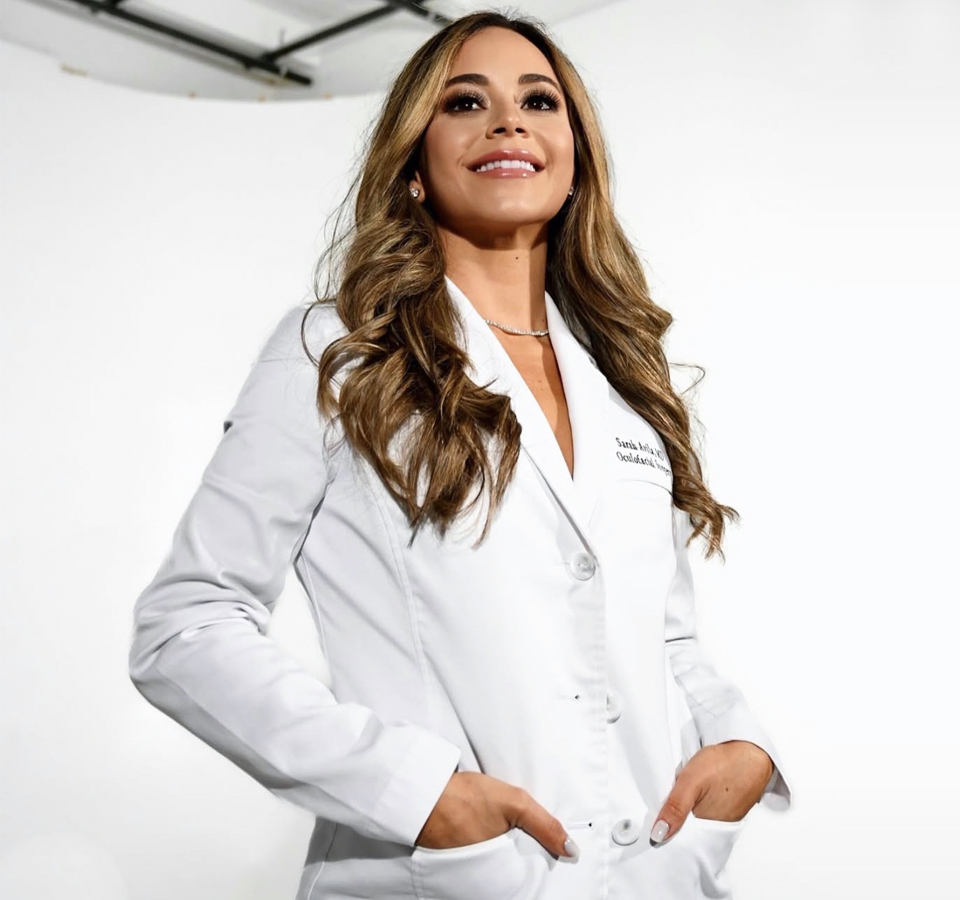Dry Eye Syndrome

Table of ContentsToggle Table of ContentToggle
What Is Dry Eye Syndrome?
Dry Eye Syndrome, also known as keratoconjunctivitis sicca or simply dry eyes, is a common eye condition that occurs when the eyes do not produce enough tears or when the quality of the tears is insufficient. Tears are essential for maintaining the health and comfort of the eyes. They provide moisture, lubrication, and a protective film over the surface of the eye, which helps to prevent dryness, irritation, and infection.
What Causes Dry Eyes?
Dry Eye Syndrome occurs when there is an imbalance in the tear film, which may result from various factors. Tears are composed of three main layers: an oily (lipid) layer, a watery (aqueous) layer, and a mucous layer. Each of these layers plays a critical role in maintaining the health and comfort of the eyes. The causes of dry eyes can involve one or more of the following factors:
- Reduced Tear Production (Aqueous Deficiency):
- Aging: As people get older, tear production tends to decrease, leading to a higher prevalence of dry eyes in older individuals.
- Hormonal Changes: Hormonal fluctuations, such as those that occur during menopause, during pregnancy, or while taking certain birth control pills, can affect tear production.
- Medical Conditions: Conditions like Sjögren’s syndrome, rheumatoid arthritis, and lupus can lead to reduced tear production due to their autoimmune nature.
- Medications: Some medications, including antihistamines, decongestants, diuretics, and certain antidepressants, can have dry eyes as a side effect.
- Poor Tear Quality (Lipid Deficiency):
- Meibomian Gland Dysfunction: The meibomian glands in the eyelids produce the oily component of tears. If these glands become clogged or don’t function correctly, it can lead to poor tear quality and rapid tear evaporation.
- Blepharitis: Inflammation of the eyelid margins can disrupt the secretion of oils from the meibomian glands and contribute to dry eyes.
- Rosacea: A skin condition, particularly when it affects the eyelids and surrounding areas, can lead to meibomian gland dysfunction.
- Increased Tear Evaporation:
- Environmental Factors: Exposure to dry, windy, or dusty environments can increase the rate at which tears evaporate from the eye’s surface.
- Prolonged Screen Time: When using computers, smartphones, or other screens, people tend to blink less frequently, reducing the even distribution of tears and increasing evaporation.
- Delayed Blinking: Any condition such as eyelid malposition, facial paralysis, or Parkinson’s Disease that makes a person blink less can cause dry eyes.
- Autoimmune Disorders: Conditions like Sjögren’s syndrome and systemic lupus erythematosus, which involve autoimmune reactions, can affect the lacrimal glands responsible for tear production.
- Eye Surgery: Certain eye surgeries, such as LASIK or cataract surgery, can temporarily disrupt tear production or lead to dry eyes as a side effect.
- Contact Lenses: Wearing contact lenses, especially extended-wear or poorly fitting lenses, can contribute to dry eye symptoms.
- Medical Conditions: Other medical conditions, such as diabetes, thyroid disorders, and vitamin A deficiency, can increase the risk of developing dry eyes.
- Neurological Disorders: Nerve damage or dysfunction in the cornea or the lacrimal gland can lead to decreased tear production.
It’s important to note that dry eye causes can be multifactorial, with a combination of factors contributing to the condition.
What Are the Symptoms of Dry Eyes?

- Dryness: A persistent sensation of dryness or grittiness in the eyes is a hallmark symptom of dry eyes.
- Burning or Stinging: The eyes may feel as though they are burning or stinging, often due to irritation from a lack of adequate tear film.
- Itching: Dry eyes can lead to itching, causing a constant urge to rub the eyes, which may exacerbate the problem.
- Redness: The eyes may appear red or bloodshot due to irritation and inflammation.
- Blurry Vision: Vision can become intermittently blurry, especially when blinking. This occurs because the tear film is not evenly distributed over the surface of the eye.
- Excessive Tearing (Watery Eyes): Paradoxically, dry eyes can lead to excessive tearing as a reflex response to the irritation. These “reflex tears” are different from the normal, balanced tears that maintain eye health.
- Sensitivity to Light (Photophobia): Dry eyes can increase sensitivity to light, making it uncomfortable to be in brightly lit environments.
- Eye Fatigue: Prolonged visual tasks, such as reading or using a computer, can lead to eye fatigue and discomfort.
- Stringy Mucus: A sticky or stringy discharge may develop, particularly upon waking in the morning. This is due to a lack of the mucous component in the tear film.
- Discomfort When Wearing Contact Lenses: Individuals who wear contact lenses may experience discomfort, reduced wearing time, and an increased likelihood of lens intolerance.
- Feeling of a Foreign Body: Some people may feel as if there is a foreign object, like sand or an eyelash, in their eye, even when there isn’t.
- Eye Pain: In more severe cases, dry eyes can lead to eye pain or aching.
How Are Dry Eyes Treated?
Treatment for Dry Eye Syndrome may involve various approaches, depending on the underlying cause and the severity of the condition. Common treatment options include:
- Artificial Tears: Over-the-counter artificial tear eye drops can provide relief by adding moisture to the eyes.
- Prescription Eye Drops: In some cases, prescription eye drops, such as cyclosporine (Restasis, Cequa), lifitegrast (Xiidra), or perfluorohexyloctane (Meibo), may be recommended to reduce inflammation and increase tear production.
- Lifestyle Modifications: Adjusting your environment, such as using a humidifier, taking regular breaks during screen time, and avoiding smoking, can help alleviate dry eye symptoms.
- Lipid-Based Eye Drops: For cases of poor tear quality, lipid-based eye drops or ointments may be used to stabilize the tear film.
- Punctal Plugs: These small plugs are inserted into the tear ducts to slow the drainage of tears from the eyes, keeping the eyes better lubricated.
- Anti-Inflammatory Medications: In cases of chronic or severe dry eye, your eye doctor may prescribe anti-inflammatory medications, including steroids or topical immunosuppressants.
- Meibomian Gland Expression: This procedure is used to unclog the meibomian glands that produce the oily component of tears, improving tear quality.
- Intense Pulsed Light: IPL therapy aims to improve meibomian gland function by reducing the inflammation and softening the meibum (the oil produced by the glands). This can lead to clearer and healthier meibomian gland secretions, which help stabilize the tear film.
What Are Punctal Plugs for Dry Eyes?
Punctal plugs, also known as lacrimal plugs or punctal occluders, are small, biocompatible devices that are inserted into the tear ducts (puncta) of the eyes. These devices are used as a treatment option for individuals with dry eye syndrome to help retain and conserve the natural tears produced by the eyes. The primary function of punctal plugs is to block the drainage of tears from the eye’s surface into the nasolacrimal duct and down into the nasal cavity.
By preventing the rapid drainage of tears, punctal plugs can:
- Increase Tear Retention: Punctal plugs help keep the tears on the surface of the eye longer, allowing the eyes to stay moist and reducing the symptoms of dry eyes.
- Improve Tear Film Stability: By maintaining a stable tear film, punctal plugs can contribute to better eye comfort and reduced dryness.
- Enhance Lubrication: The increased tear retention can alleviate sensations of dryness, burning, and irritation in the eyes.
Punctal plugs come in various shapes and materials, and the choice of which type to use may depend on the individual’s specific needs. The plugs are typically made of silicone or collagen, and they can be temporary or permanent.
There are two main types of punctal plugs:
- Temporary Punctal Plugs: These are made of dissolvable materials, such as collagen or hydrogel, and are designed for short-term use. They can provide relief from dry eye symptoms without the need for a permanent commitment.
- Permanent Punctal Plugs: These plugs are typically made of silicone or acrylic and are intended for long-term or permanent use. They require a more involved procedure for insertion and removal.
The insertion of punctal plugs is a straightforward and typically painless procedure. Dr. Sarah Avila is a board-certified oculofacial surgeon specializing in complex breakthrough dry eye syndrome. During consultation, Dr. Sarah Avila will determine the suitable type and size of plugs for your individual condition. The plugs are inserted into the puncta in a simple office-based procedure and can be easily removed if necessary.
What Is Intense Pulsed Light (IPL) for Dry Eyes?
Intense Pulsed Light (IPL) therapy is a non-invasive medical procedure that has gained attention as a potential treatment for certain types of dry eye disease, specifically meibomian gland dysfunction (MGD). Meibomian glands are responsible for producing the oily component of tears that helps prevent tears from evaporating too quickly. When these glands become clogged or dysfunctional, it can lead to evaporative dry eye.
IPL therapy was originally developed for dermatological treatments, such as reducing the appearance of vascular lesions and skin pigmentation issues. However, it has since been adapted for use in ophthalmology and optometry to address meibomian gland dysfunction. Here’s how it works:
- Procedure: During an IPL session for dry eye disease, a handheld device that emits pulses of high-intensity light is used. The light is filtered to specific wavelengths that target the blood vessels and inflammation around the eyelids.
- Absorption of Light: The targeted light is absorbed by the blood vessels and inflammation, causing them to constrict and potentially reduce the inflammation.
- Improving Meibomian Gland Function: IPL therapy aims to improve meibomian gland function by reducing the inflammation and softening the meibum (the oil produced by the glands). This can lead to clearer and healthier meibomian gland secretions, which help stabilize the tear film.
IPL therapy for dry eye disease is often considered for individuals with moderate to severe evaporative dry eye due to meibomian gland dysfunction, particularly when other treatments like warm compresses, lid hygiene, and artificial tears have been ineffective. Dr. Sarah Avila is a board-certified oculofacial surgeon specializing in IPL for dry eye syndrome.

Sarah Avila, MD
Board Certification:
Oculofacial Plastic Surgery
Specialization:
Eyelid Surgery & Aesthetics
Dr. Sarah Avila is a Double Board-Certified Oculofacial Plastic Surgeon in Miami, Florida. After completing medical school, Dr. Avila completed a residency in ophthalmology at the Mount Sinai Hospital, followed by a highly competitive two-year ASOPRS-accredited fellowship in reconstructive and cosmetic oculofacial surgery at Emory University.






